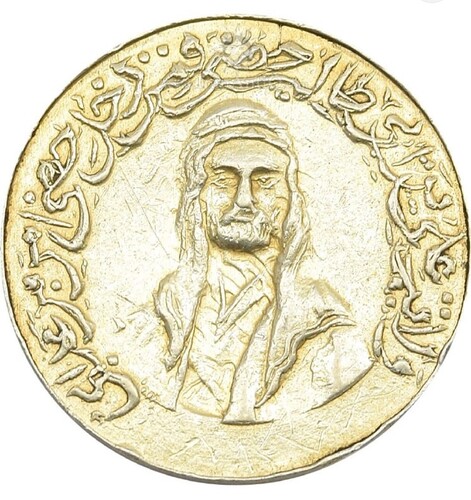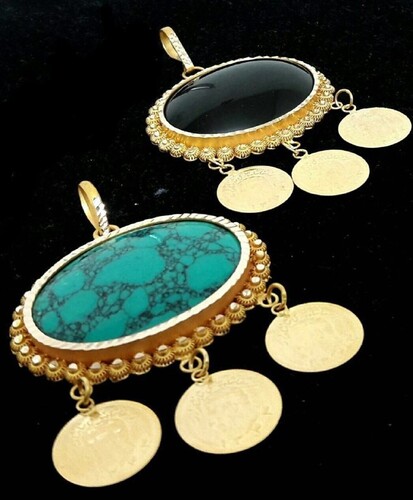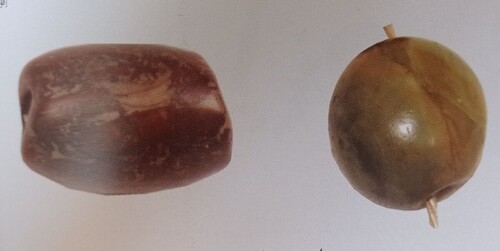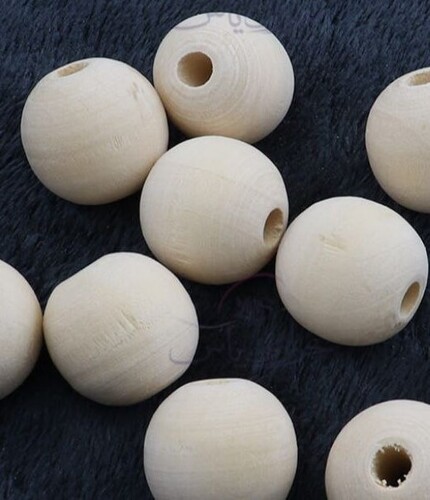Sardast/ Sarqol
It is a piece of gold ornament. It looks like Sarpshtwen with Pahlavi coins hanging on it. It is as long as the part of the sleeve that is kept on the wrist. In the past, they used to sew it to Kawa sleeves because in the past they used to make the dresses' sleeves with Sorani. Nowadays, the dresses' sleeves are simply made so the Sardast can be sewn to the dress directly.

Shamrakht
It is a kind of necklace made with a thick gold chain, as long as the waist, and it has a large medallion of five Pahlavi or ten Pahlavi coins in the middle of the chain, and smaller gold coins and medallions are attached to the chain all the way to the neck. The coins and medallions can be simple or have marginal ornaments. Shamrakht is the same as "Liran Barmour" that was used in the past, however, it is made with chains, not sequins or pearls.

Kochka
It is a piece of gold jewelry that looks like a hill with several holes in it. They hang large medallions to the middle part, and its chain on the sides.

Shoraba
Any kind of jewelry that is hanging over a chain.

Shamayal
A kind of coin that only one side of it is designed to have a figure of "Imam Ali". They wear it to be safe from any bad luck or evil eye.
Shamayal Dourou
A gold coin that has "Imam Ali" figure on one side and "Mohammad", the prophet, on the other side.

Qash
A kind of large and flat stone with a gold margin. They used to make a small ring on one side of Qash to make it possible to use it as a medallion on chains, Mekhakband, or Barmour. They also used to sew it to Kawa. Nowadays, they hang it over a chain that is as long to reach the waist. It can be made simple or with small coins hanging on it.


Mourou Brinji
It is a kind of sequin as big as a piece of rice. It has a hole in the middle and it is made in black or blue colors. It can be used as an anklet or necklace.

Mourou Pazar
It is a kind of valuable pearl like stone. It can be small or large and it is used with "Barmour" for necklaces.
Dawdarman
If someone is sick and nobody can help them, they make a bracelet with this kind of jewelry and make them wear it. If the stones of this bracelet begin to break one by one, they believe that the sickness is leaving that person's body and they will get better soon. Simply, it can absorb the illnesses.

Mourouta
It is a king of red opal. When someone had a fever, they used to put it on their body to help them feel better.
This stone also is used to protect people from sicknesses.

Mouroutawk
It is a kind of wooden ornament that looks like pearls.

Belief:
When the nonbelievers attacked the Muslims' camels, the prophet Mohammad wrote a piece of pray but they found it and threw it away, thus, the prophet told his companions to use Dartawki on their camels' saddles and this time the nonbelievers could not disturb them.
Mourou tawk can be worn with blue mourou for protection against evil eyes.
Mourou Tawk is holy. People hang it in their homes, on their kids' shoulders, on their farm animals' necks, or hang it on their wells' walls for protection.
Any tent that has a Mourou dartawk will never be damaged by thunders or strong winds.

Mourou Toushouti
It is a kind of blue, green, or red sequin combined with other kinds of ornaments that can be used to make necklaces.

Mourou Toukalak
It is a kind of sequin that looks like melon seed. It has different colors of blue or red and it can be used to make necklaces.

Mouroutarza
It is a kind of white sequin that is red on the inside. It can be combined with other kinds of ornaments to be used in necklaces.
Belief:
Mouroutarza is dropped along with hail.
Anyone who has seen mouroutarza will be lucky.
Dawdarman
This kind of mourou is good for illnesses.

Mourou Tashwetash
A kind of small glass mourou, with angles on different sides of it. It can be combined with Mekhakband to be made into a necklace. It can also be combined with other kinds of mourou, Lira, or coins. It is also used to make Kurmaka.


Source:
"Clothes and Jewelry of Women in Mukeryan Encyclopedia"
Leila Nourani, Salah Payaniyani








